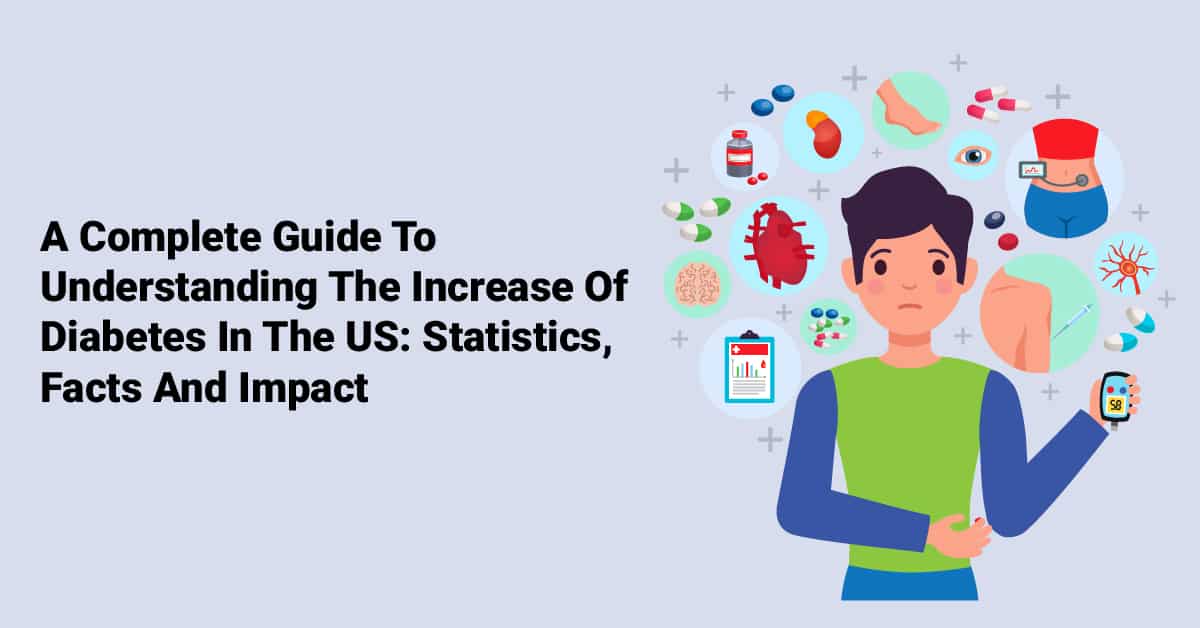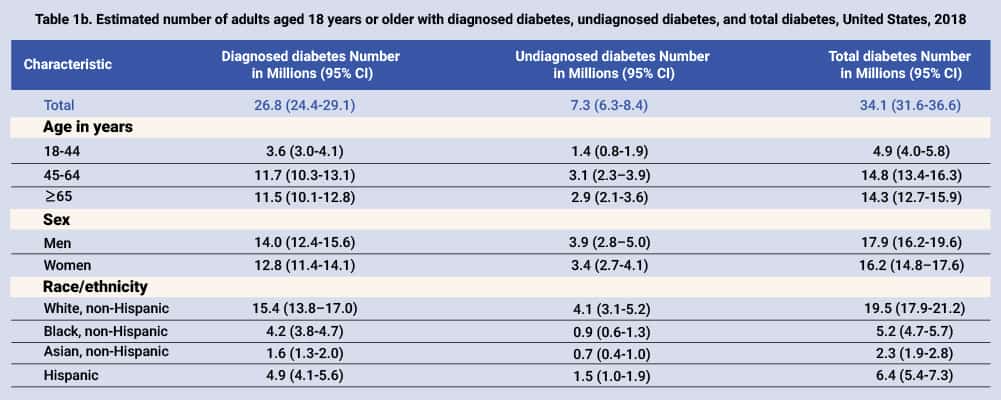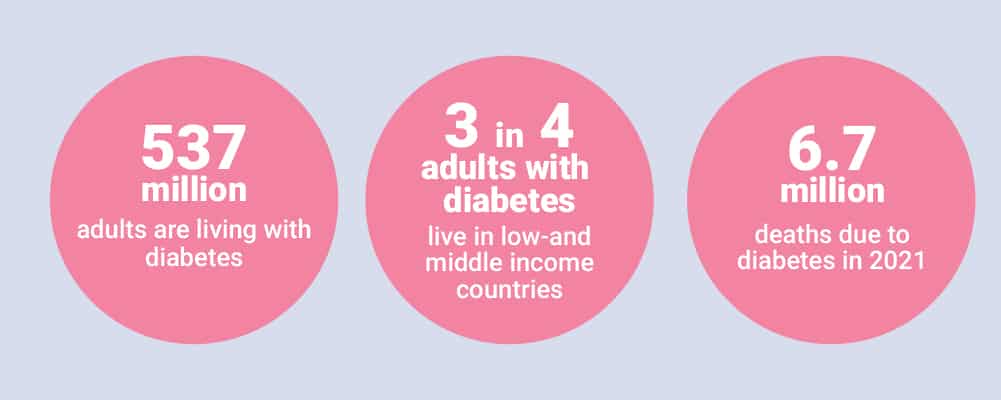The chances are that you know someone with diabetes – whether this is a friend, a family member, or even yourself.
Today, the number of individuals living with diabetes is higher than ever before with people of all ages seeing a significant negative impact on their overall health due to the disease.

One of the best ways to manage or prevent the symptoms of diabetes from overtaking your life is to understand what it is, what it does, and how it has impacted life in the US over the last few decades and continues to do so.
This guide will help you do all of these things while also providing you with some vital statistics to showcase the increase in diabetes in the US in recent years.
US Diabetes Statistics

How Many People Have Diabetes in the US?
The impact of diabetes on the general US population is pretty extreme – so much so that approximately 1.4 million Americans are diagnosed with the disease each year!
According to 2019 figures from the American Diabetes Association, more than 37.3 million Americans have diabetes, which is around 11.3% of the total US population. These statistics also show the following:
Diabetes Types
Type 1
Type 1 diabetes causes glucose (sugar) levels to become too high due to a lack of insulin production, a hormone that controls blood glucose. An individual with this type of diabetes will need to take insulin each day to keep glucose levels level and under control.
As of 2019, nearly 1.9 million Americans have been diagnosed with type 1 diabetes, including about 244,000 children and adolescents.
Type 2
Type 2 diabetes is the most prevalent type of diabetes in the US amongst diagnosed adults.
It usually develops in individuals over the age of 45. Yet due to a combination of lifestyle and genetic factors, more children, teenagers, and young adults are also developing symptoms of the disease nowadays.
Studies have recorded that around 1 in 10 or 37 million Americans have diabetes, with approximately anywhere between 90 and 95% of them suffering from type 2.
Prediabetes
Prediabetes is a serious health condition where blood sugar levels are higher than the normal level, but aren’t high enough to be diagnosed officially as type 2 diabetes.
Having prediabetes puts you at considerable risk of developing heart disease, stroke, and type 2 diabetes in the future.
There are some key figures you should be aware of. To start, approximately 98 million adults in America (around 1 in 3) have prediabetes. Of these people, over 80% aren’t aware that they have prediabetes. A larger percentage of men in the US (37.4%) are said to suffer from prediabetes than women (29.2%).
Gestational Diabetes
Gestational diabetes is a high blood sugar disorder that develops during pregnancy. It will sometimes disappear quite soon after giving birth or, in more extreme cases, may develop into type 2 diabetes.
Each year, anywhere from 2 to 10% of pregnancies in the US are impacted by gestational diabetes. Ensuring that you manage your diagnosis will help you on your way to a healthier pregnancy and a healthier baby.
Specifically, around 6% of women who gave birth in 2016 suffered from gestational diabetes.
About 50% of women in the US who have gestational diabetes will develop type 2 diabetes.
Age
The following data features the average percentages of US adults with diagnosed diabetes according to their age group:
- Ages 18-44 – 3.3%
- Ages 45-64 – 2.4%
- Ages 65-74 – 21.4%
- Ages 75+ – 21.8%
While the clear majority of people living with diabetes in the US are older than 65 and have type 2 diabetes, it’s becoming far more common to see adults receiving a diagnosis of type 2 diabetes at a younger age.
At the same time, the prevalence of type 1 diabetes is increasing in all age groups (see more about the increase of diabetes diagnoses later in this post)
Ethnicity
There is quite a bit of evidence that suggests that certain ethnic groups are more predisposed to develop type 2 diabetes than others.
In the US, the overall percentage rates of diagnosed cases of diabetes in US adults according to race or ethnic background can be summarized as follows:
American Indians or Alaskan Natives – 14.5%
Non-Hispanic Blacks – 12.1%
Hispanics – 11.8%
Asian Americans – 9.5%
Non-Hispanic White People – 7.4%
Asian Americans
Chinese – 5.6%
Filipinos – 10.4%
Asian Indians – 12.6%
Other Asian Americans – 9.9%
Central And South Americans – 8.3%
Hispanic Adults
Cubans – 6.5%
Mexican Americans – 14.4%
Puerto Ricans – 12.4%
Increase Of Diabetes In The US

Between the years 1999 and 2016, the age-adjusted prevalence of total diabetes increased significantly among adults aged 18 or older.
This saw around 1.4 million new cases of diabetes being diagnosed among US adults over the age of 18 in 2019.
Prevalence estimates remained at around 9.5% from 1999 to 2002 and then 12% from 2013-2016. During this period, the age-adjust prevalence increased relatively significantly for diagnosed diabetes.
Diabetes Type
Type 1
According to a 2020 report by the CDC, the number of people with type 1 diabetes in the US is increasing rapidly. This report estimates a nearly 30% total increase in type 1 diabetes cases within the US since 2017.
Type 2
Type 2 diabetes is rising at an alarming rate in the US. According to a 2016 study, the prevalence of type 2 diabetes increased by 120% between 2001 and 2014.
Gestational
Pregnancy-based diabetes has also increased in the US in recent years. Recent studies found that between the years 2000 and 2010, the overall percentage of US pregnant women with gestational diabetes increased by 56%, and the percentage of women with either type 1 or type 2 diabetes before pregnancy increased by 37%.
Prediabetes
We’ve already established that approximately 96 million American adults were living with prediabetes in 2019. Yet we must also consider the impact of this condition on different age categories.
Among all US adults over the age of 18, crude estimates between 2017 and 2020 for the different age categories were as follows:
- Age 18-44: approximately 27.8% of adults in this age category had prediabetes. This equated to about 32.2 million of the US adult population.
- Age 45-64: around 44.8% had prediabetes. This figure equals approximately 37.4 million people in the US.
- Age 65+: approximately 48.8% were living with diabetes. This accounted for nearly 26.4 million adults diagnosed with the condition.
Additionally, in 2017, approximately 352 (7.3%) million adults worldwide were living with prediabetes. This global figure is expected to rise to 587 million (8.3%) by 2045.
Cost Of Diabetes In The US

High Cost Of Diabetes
With billions of dollars spent on covering medical costs for this disease each year, diabetes is the most expensive chronic condition in the US.
We’ll delve into some global and US-only figures for you to take a closer look at.
The US Figures
In terms of the United States, the number of adults living with diabetes is expected to rise to 40 million by 2030 and then to around 49 million by 2045. With such a huge jump in diagnosed individuals, it’s to be expected that the high costs of diabetes will also continue to grow.
Around $1 of every $4 spent on US health care costs is spent providing care for those with diabetes. In 2017, around $237 billion was directly spent on medical costs while another $90 billion is spent on reduced productivity.
Breakdown Of Medical Expenditure
To begin understanding how this figure came about, it’s important to look at a breakdown of individual costs. For example, the average medical expenditure for an individual diagnosed with diabetes during this year was $16,752 — with around $9,600 of this attributed to undiagnosed diabetes.
According to a study carried out by the American Diabetes Association (ADA), medical expenditure for an individual with diabetes can be separated into the following percentage categories:
- Prescription medications to combat diabetes complications (30% of the total cost)
- Hospital inpatient care (30%)
- Anti-diabetic agents and diabetes supplies (around 15% of medical costs)
- Physician office visits (approximately 13% of costs)
This figure makes sense considering people who have officially been diagnosed with diabetes typically have medical expenditure that is approximately 2.3 times higher than those who don’t have the disease.
According to the same study by ADA, the total economic cost of diabetes is shown to have increased by 60% from 2007 to 2017.
Diabetes Worldwide

Statistics And Growth
In 2021, diabetes caused at least USD 966 billion in total health expenditure. This is a 316% increase over the last 15 years and is a crucial way of demonstrating the ever-present impact of diabetes on those suffering from the condition.
According to a 2021 data portal, the number of adults living with diabetes (between 20 and 79 years of age) is said to be around 537 million. The number of adults living with diabetes on a global scale is predicted to increase to a staggering 643 million by 2030 and then 783 million by the year 2045.
Unfortunately, around 46% of people living with the disease are living undiagnosed. This is approximately 1 in 11 of the world’s adult population.
As a result of so many people living with diabetes, the global costs are predicted to almost double to an eye-watering $2.5 trillion by 2030!
Over 6.7 million deaths were caused by diabetes globally in 2021.
Diabetes Health Impact
Between the years 2000 and 2016 there was a 5% increase in the rate of premature mortality from diabetes.
In 2019, diabetes became the ninth leading cause of death on a global scale, with an estimated figure of 1.5 million deaths stemming directly from the disease. 48% of these deaths occurred before the age of 70.
In 2021, over 410,000 US deaths were caused by diabetes (directly or indirectly).
Individuals with the disease can also suffer from a whole variety of other health issues that are, at least partially, caused by their diabetes. These differ from person to person and depend on individual circumstances as well as how badly the disease has progressed over time.
Here are some of the more common ways that diabetes impacts health:
Blindness
People living in the US with type 1 and type 2 diabetes are at a heightened risk of developing blindness or general eye complications. Diabetes is one of the leading causes of blindness in adults.
There are a few eye diseases that could lead to blindness and are generally made far worse by diabetes.
Organ Failure
Another way that diabetes may impact health is by leading to organ failure. Having high levels of sugar in your blood could cause many issues all over your body including kidneys, brain, eyes, and heart. This could also lead to kidney disease and kidney failure over time.
High glucose levels can cause irreversible damage to blood vessels in your kidneys which means that they will cease functioning at a high level. Kidney damage or failure may raise the risk of developing cardiovascular issues and might even lead to greater chances of a stroke or heart attack occurring.
There are several ways that kidney failure impacts the heart. To begin with, fluid will start building up around the lungs, body tissue, and the heart which could place unneeded stress on the organs and cause a lethal rise in blood pressure.
In individuals with diabetes, decreased lung function and capacity may be caused by inflammation. This could get much worse as the blood glucose levels increase because of the presence of diabetes. Adults with diabetes are 8% more likely to have asthma than those without the disease.
Risk Of Heart Disease
Diabetes and heart disease have strong links with one another. Heart disease is the leading cause of death for men and women in the US.
If you have diabetes – diagnosed or not – you are generally far more likely to have a stroke or heart disease than someone who doesn’t have diabetes. And the longer you have diabetes, the more likely you are to develop heart disease.
High blood sugar can cause significant damage to blood vessels and nerves controlling the heart over time. High blood pressure, too much “bad” cholesterol in your bloodstream, and high triglycerides can also be huge contributors to heart disease by damaging artery walls.
Unfortunately, none of these conditions have obvious symptoms. A doctor will need to carry out tests to check these levels. If they are high, immediate action must be taken. Some major factors could increase the risk of developing heart disease:
- Obesity or being overweight
- Smoking
- Consuming too much alcohol
- Not exercising regularly
- Eating a diet high in cholesterol, saturated fats, sodium, and trans fat
Individuals with diabetes are far more likely to experience heart failure where the heart fails to pump blood well. Early diagnosis and treatment could work to relieve symptoms or stop the disease in its tracks.
Risk Of Stroke
Living with diabetes increases your risk of getting a stroke. This is because you are far more vulnerable to developing cardiovascular disease.
Strokes happen due to a disruption in the blood supply to the brain. The majority of strokes occur as a blood clot blocks a vital blood vessel in the neck or brain.
A stroke could have many lasting effects including movement issues, numbness, cognitive problems, and pain. Many people struggle with emotional problems like depression after going through a stroke.
Increased glucose levels from living with diabetes can cause significant damage to the blood vessels, and cause a blood clot which will increase the risk of having a stroke if it travels to the brain.
To prevent a stroke, people with diabetes should control their blood glucose, cholesterol, blood pressure, and weight.
If you have diabetes, look out for the following symptoms:
- Trouble talking
- Mobility or balance issues
- Dizziness
- Abrupt confusion
- Double or blurred vision
- Numbness or weakness on one side of the face or body
Limb Amputation
In the US, every 17 seconds someone new is diagnosed with diabetes. And approximately 230 Americans with diabetes require an amputation every day.
If you have diabetes you are at higher risk of having poor blood circulation and nerve damage. These health problems could make the feet more vulnerable to ulcers or skin sores that can quickly worsen to a point where they require amputation.
Yet by guaranteeing proper diabetes management, the risk of lower limb amputations will be significantly reduced. Better diabetes care is a huge reason why the rates of these amputations have gone down by almost 50% in the last two decades.
If foot ulcers develop, then urgent care is a must. A large percentage (around 80%) of amputations begin with the formation of ulcers on the feet which then go on to damage bone and tissue.
A nonhealing ulcer will likely require surgical removal of a lower limb. Treatments for foot ulcers will vary depending on the overall severity of the wound.
However, there are ways of preventing foot ulcers and, by association, reducing the risk of limb amputation:
- Carrying out daily foot inspections
- Washing the area daily
- Not removing lesions or calluses yourself
- Have shoes that fit properly
- Only wear clean, dry socks
- Attend regular foot checkups (at least once a year)
Summary

After reading this guide we hope you have a better understanding of the increase of diabetes in the US in terms of statistics, facts, and its overall impact on US citizens.
Unfortunately, there is no cure for diabetes which means it continues to impact the lives of millions of US citizens every year.
Diabetes is a medical condition that is incredibly rich with data. This is thanks to the rapid expansion of type 2 diabetes in the US — with millions more people being diagnosed each year — which increases society’s need for more reliable data.
As a result of its increasing presence in the general US population, diabetes has a huge socioeconomic impact that continues to interrupt the lives of millions of people every year.



